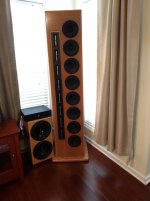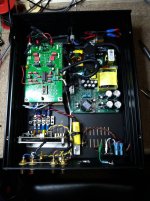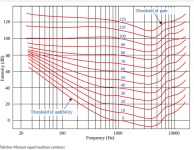How demanding should an audiophile be about the quality of the amplifier for the subwoofer?
I ask because it seems difficult to imagine what we can hear. For full range speakers, distortion and transient response are obviously important. Because the speakers are full range, they presumably participate in the full transient response. Also, any harmonic distortion is within range of the speakers' reproduction.
With a subwoofer, though, harmonics might be rolled off. I'm also a little fuzzy about what "transients" might be after they've gone through a low-pass filter. Sure, if the subwoofer waveform were synthesized from raw waveforms without a low-pass, then transients could be incredibly sharp. i.e. a dedicated LFE channel is not necessarily band-limited. But a low-pass filter on a full-range sound source will smooth out transients significantly, and I wonder how the subwoofer can have a sharp transient response after things have been rolled off.
In my setup, I have a passive subwoofer cabinet, fed by a full range amplifier, which is fed by a DAC. The low-pass filtering is done on a mono mix of the stereo input, through a Linkwitz-Riley crossover (low output only - my full range speakers are still full range, not high-pass), and the final signal is dithered before the 24-bit DAC to hopefully remove truncation noise. The catch here is that any harmonic distortion in the power amplifier will be passed to the subwoofer driver without any low-pass filtering.
Besides the questions above, I'm also wondering whether the ideal subwoofer might still have some passive low-pass filtering components in between the amplifier output and driver. Unfortunately, this would make varying the cutoff difficult compared to the pure DSP setup I have now. But a possible advantage would be to minimize harmonic distortion, whatever there may be.
I guess the core of my question is: What do we perceive when listening to a subwoofer, and what would the audiophile concerns be to focus on improving?
p.s. I'm ignoring the size of the cabinet, resonant frequency, ported versus non-ported, isobaric versus other mechanical aspects of subwoofer design. I think I have a fairly good understanding of those aspects of quality. I'm trying to focus on the amplifier, signal processing, and those aspects.
I ask because it seems difficult to imagine what we can hear. For full range speakers, distortion and transient response are obviously important. Because the speakers are full range, they presumably participate in the full transient response. Also, any harmonic distortion is within range of the speakers' reproduction.
With a subwoofer, though, harmonics might be rolled off. I'm also a little fuzzy about what "transients" might be after they've gone through a low-pass filter. Sure, if the subwoofer waveform were synthesized from raw waveforms without a low-pass, then transients could be incredibly sharp. i.e. a dedicated LFE channel is not necessarily band-limited. But a low-pass filter on a full-range sound source will smooth out transients significantly, and I wonder how the subwoofer can have a sharp transient response after things have been rolled off.
In my setup, I have a passive subwoofer cabinet, fed by a full range amplifier, which is fed by a DAC. The low-pass filtering is done on a mono mix of the stereo input, through a Linkwitz-Riley crossover (low output only - my full range speakers are still full range, not high-pass), and the final signal is dithered before the 24-bit DAC to hopefully remove truncation noise. The catch here is that any harmonic distortion in the power amplifier will be passed to the subwoofer driver without any low-pass filtering.
Besides the questions above, I'm also wondering whether the ideal subwoofer might still have some passive low-pass filtering components in between the amplifier output and driver. Unfortunately, this would make varying the cutoff difficult compared to the pure DSP setup I have now. But a possible advantage would be to minimize harmonic distortion, whatever there may be.
I guess the core of my question is: What do we perceive when listening to a subwoofer, and what would the audiophile concerns be to focus on improving?
p.s. I'm ignoring the size of the cabinet, resonant frequency, ported versus non-ported, isobaric versus other mechanical aspects of subwoofer design. I think I have a fairly good understanding of those aspects of quality. I'm trying to focus on the amplifier, signal processing, and those aspects.
By the way, I realize that my question is not exactly about the subwoofer itself as a loudspeaker, but about the signal chain feeding the subwoofer. I could not find another forum here on DIY Audio that seemed more appropriate, but if I should be asking this question elsewhere then please let me know.
Two things:I use a servo sub [snip]
The Hypex class D amp for the win.
One) What were your criteria for rating the winner?
That's the core of my question. I don't want to skip to "what's the best amp?" I want to know what should be considered when deciding on the best amp.
Two) Servo technology is amazing. I also have the self-powered Paradigm servo 15" in my home theater. My understanding is that the amplifier must be involved in the servo feedback, so it seems like the choices are limited. Most general purpose amplifiers do not have a servo input.
i.e. It ain't servo without the feedback.
Subwoofer amplifier sound quality is less important due to % distortion being less audible (to the listener) the longer the wavelength. Audiophiles are concerned with a lot of characteristics such as warmth, brightness, artefacts production etc that don't really apply in the lowest couple of octaves.
Audiophiles spend less time talking about power too, which IMO is very important especially for subs. Even the most expensive amplifiers in the world sound rubbish when the volume gets cranked and theres ho headroom.
Hypex and icepower class d modules are almost the reference for high quality subwoofer duty amps, spending anymore is likely pointless. Theres a lot of audiophile grade full range amps that have ncore modules nowadays, they cost 4 times more just to get the brand label and a user interface display with some configuration.
Audiophiles spend less time talking about power too, which IMO is very important especially for subs. Even the most expensive amplifiers in the world sound rubbish when the volume gets cranked and theres ho headroom.
Hypex and icepower class d modules are almost the reference for high quality subwoofer duty amps, spending anymore is likely pointless. Theres a lot of audiophile grade full range amps that have ncore modules nowadays, they cost 4 times more just to get the brand label and a user interface display with some configuration.
Subwoofer amplifier sound quality is less important due to % distortion being less audible (to the listener) the longer the wavelength.
I'm afraid this is the opposite of true.
A brief perusal of the Equal Loudness Contours will tell you why.
Chris
How demanding should an audiophile be about the quality of the amplifier for the subwoofer?
I ask because it seems difficult to imagine what we can hear. For full range speakers, distortion and transient response are obviously important. Because the speakers are full range, they presumably participate in the full transient response. Also, any harmonic distortion is within range of the speakers' reproduction.
Distortion is mainly created by the driver itself, professionally usually specified as 10% with Xmax. It cannot be reduced with any low pass filters, neither passive or active. It is level dependent and with a lot of 2nd order because of asymmetric suspension. Only a better driver will make a difference.
Additional distortion is caused by over-driven amps, also not filterable active, but passive. It is mainly 3rd+ order, because the DC-servo centers it.
If the amp works in the linear region it is very low, maybe 0.3% for shitty amps and not distinguishable from the driver, so people tend to crank up too much. A more powerful amp will not clip and is "better".
Rather measure with REW and mike.
Most new products use class d amps like the hypex because of their price, not their ultimate quality. Its simply too expansive and complicated to use class ab for example. Heat and space are also problematic.
From the quality point of view, you would go high end class ab. At the moment im using a pass labs ab100 for my sub and it sound a lot better, than much stronger class d amps.
Also as stated above, distortion matters even more at low frequencies, but its hard to fight it there.
Its also not always a driver problem. Instead of 1 big driver with lots of problems i use 2 smaller ones with their own amps and this way you can also fight distortion.
From the quality point of view, you would go high end class ab. At the moment im using a pass labs ab100 for my sub and it sound a lot better, than much stronger class d amps.
Also as stated above, distortion matters even more at low frequencies, but its hard to fight it there.
Its also not always a driver problem. Instead of 1 big driver with lots of problems i use 2 smaller ones with their own amps and this way you can also fight distortion.
Last edited:
Hi Chris, could you please elaborate in layman's terms? Cheers
Sure.
Our ears lose sensitivity as the frequency decreases. Because of that slope, we're more sensitive to harmonic distortion in the bass, as that means the driver is also producing sound in our more sensitive hearing range.
Chris
If you want to work at decreasing bass distortion then the smart play is a bandpass enclosure, yeah? An acoustic low pass between the driver and the listener would work on harmonics created by the driver that couldn't otherwise be attenuated.
If there is one place where amps just need to give clean but enough power it's on subs, and that is where class D (when done right) shines. The main thing is enough power, and a psu that can follow so you don't get sagging or distortion because the psu runs out of steam. Class A or AB have no advantage here in any way (but will work also when powerfull enough).
Tube amps can give some extra, but it's very subjective if that is good or not. But a Hypex Ncore or their (Ncore) Fusion plate amps are objectivly probally one of the best choices now, except if you like the tube sound or when you need more power.
Tube amps can give some extra, but it's very subjective if that is good or not. But a Hypex Ncore or their (Ncore) Fusion plate amps are objectivly probally one of the best choices now, except if you like the tube sound or when you need more power.
From the quality point of view, you would go high end class ab. At the moment im using a pass labs ab100 for my sub and it sound a lot better, than much stronger class d amps.
That is mainly because most class D amps have a PSU that is too weak, when that is not the case, class D is as good as class A or AB on subs, for tops, i agree that class A or AB is still better, but not on subs.
I don't believe there's discriminable difference among amps since 1985, at least playing into ordinary speaker loads within the amp's specs.
The big difference in subs is having multiple subs properly located in a room. Almost anything else (within reason) you can do is modest in comparison (except for motional feedback). I sure wish the acoustics forum was located here in the loudspeaker forum where it belongs. Do speakers play in vacuums?
B.
The big difference in subs is having multiple subs properly located in a room. Almost anything else (within reason) you can do is modest in comparison (except for motional feedback). I sure wish the acoustics forum was located here in the loudspeaker forum where it belongs. Do speakers play in vacuums?
B.
Last edited:
- Home
- Loudspeakers
- Subwoofers
- Audiophile quality subwoofer?


